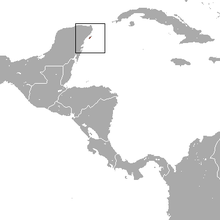Cozumel thrasher
| Cozumel thrasher | |
|---|---|
| Scientific classification | |
| Kingdom: | Animalia |
| Phylum: | Chordata |
| Class: | Aves |
| Order: | Passeriformes |
| Family: | Mimidae |
| Genus: | Toxostoma |
| Species: | T. guttatum |
| Binomial name | |
|
Toxostoma guttatum (Ridgway, 1885) |
|
 |
|
| Cozumel thrasher range | |
The Cozumel thrasher (Toxostoma guttatum) is a bird from the mockingbird family (Mimidae), which is endemic to the island of Cozumel off the Yucatán Peninsula, Mexico. It is believed to be the most critically endangered species of bird in Mexico - if it indeed still exists, which is probable but not certain.
This bird is closely related to the long-billed and brown thrasher. It has been generally described as shy, but there have been descriptions to the contrary. It was once abundant throughout Cozumel before two hurricanes greatly affected its numbers. Invasive species are also thought to have impacted the population of the thrasher.
The Cozumel thrasher was first described as Harporhynchus guttatus by Robert Ridgway in 1885. It has been described as a subspecies to its relative the long-billed thrasher, but was considered a separate species when it was determined in a 1998 study that it differed genetically more than five percent from both the long-billed and brown thrasher. In the same study it was determined to be the basal member of the rufum group of Toxostoma thrashers. The bird is monotypic.
The thrasher is 21.5 to 24 cm in length. The adult has a brown crown, back, shoulders, and rump that becomes more red in its tint on its lower back and rump. Greater and lesser coverts are a warm brown with concealed white tips, preceded with a black bar. Primaries and secondaries are grayish-brown with warm rufous-brown outer webs. The retrices are also have a warm brown color. The lores and ear-coverts are a mottled grey brown. The chin and throat are an off-white color with a blackish partial malar stripe. The chest is a buffy-white in color with stark black teardrop shaped spots. The belly is off-white, and the flanks have larger black spots. Its vent is buffy and an underwing that is buffy-white with darker markings. The iris is yellow, the bill is grayish-brown, and the legs are brown with a dull tint. Juveniles' plumage have not been recorded, but presumably is similar in development to adulthood like the long-billed and brown thrasher.
...
Wikipedia

